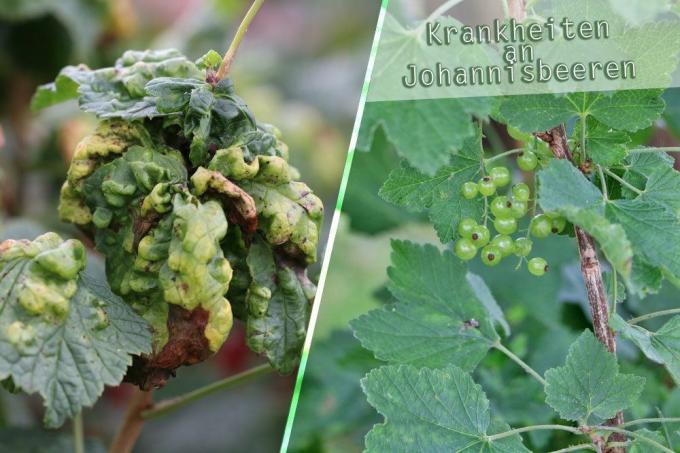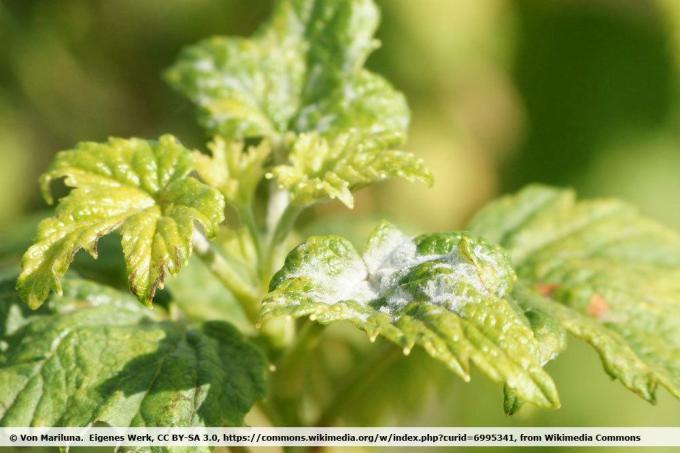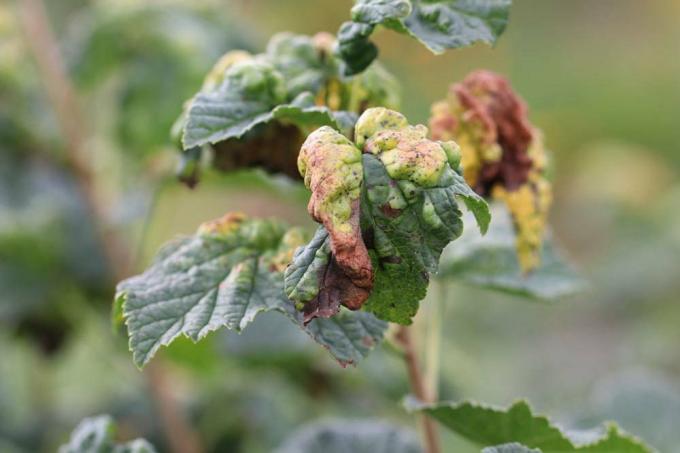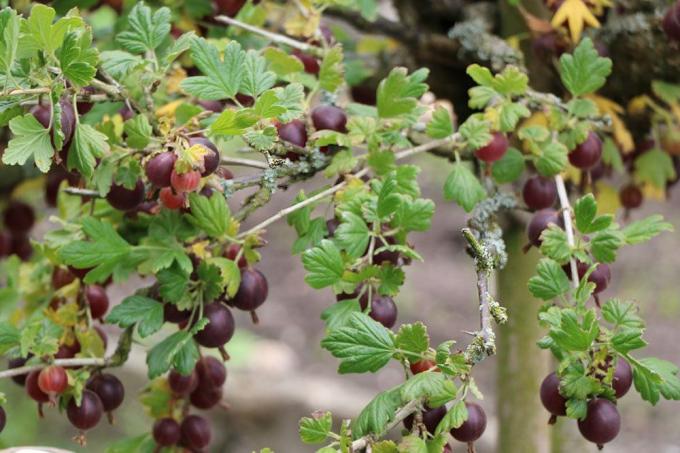
table of contents
- Diseases of currants
- American gooseberry powdery mildew
- weave
- Pillar grate
- Red pustular disease
- Stinging nettle leaves
- Colletotrichum fruit rot
- Leaf fall disease
- Instinct death
Because of their persistence and uses in the garden, currants are one of the most popular shrubs of German gardeners. Currants rarely get sick, but the plant is not immune from every disease. There are a large number of diseases that have a negative effect on the vitality of the plant and can even lead to its death. For this reason, it is important to know how to recognize and treat these on the basis of damage images.
Diseases of currants
If you are the proud owner of a currant in the garden, you definitely do not want to lose it to a disease or to give up your harvest. Currants are considered to be extremely robust and for this reason can even be kept in unsuitable locations. However, the plants are not safe from all diseases and you can suddenly face a major problem.
The most common reasons for a disease in currants are care errors and unfavorable locations. Fortunately, these can be treated with the right measures. The most susceptible to the 8 diseases that are described in detail in the following sections are red currants (bot. Ribes rubrum), while the black variant (bot. Ribes nigrum) is significantly more resistant.
American gooseberry powdery mildew
The American gooseberry powdery mildew is also under the name Currant powdery mildew known and one of the most serious diseases in currants. In Central Europe in particular, powdery mildew is a danger that should not be underestimated, as many regions have damp weather and for this reason support the spread of the fungi. Podosphaera mors-uvae is not only dangerous for the Ribes in their own garden. The powdery mildew counts as a problem for the economical cultivation of the berries. The following symptoms indicate powdery mildew:
- white coating forms on leaves
- can also attack fruits
- this looks floury
- slowly turns brown
- Leaves begin to wither
- Leaves dry up and fall off
- Shoot tips wither
- Shoot tips die off
- Fruits are inedible
You can prevent the infestation by spraying the plants regularly with a liquid that consists of either Nettles (bot. Urtica) or Field horsetail (bot. Equisetum arvense) is obtained. For first aid, follow these steps:
- remove affected leaves
- remove infected shoots
- alternatively spray nettle stock
That way, you'll get the powdery mildew under control quickly. Avoid using milk to wipe away the mildew, as removing the infected areas is healthier for the crop.

tip: If you don't want to deal with gooseberry powdery mildew, you should rely on growing resistant varieties that have no problem with the fungi. These include the sweet and sour 'Neva', the juicy 'Black Marble', the sweet 'Blackbells' and the bitter 'Late Night', which are great in your own garden.
weave
Lichen is a combination of algae and fungi that accrue from neglecting your currants. In itself, the growths of lichens recover when they become sick from them. The damage can still be alarming:
- Flower formation fails
- Crop failure follows
Lichen is quite easy to spot and can be kept in check with a regular cut. Be sure to take care of this, as many pests use lichens as protection.
Pillar grate
The pillar rust is a disease on currants that you can hardly fight. The cause of this is the fungus Cronartium ribicola, which persists in fruit trees over the summer and changes to five-needle pines over the winter:
- Swiss stone pine (bot. Pinus cembra)
- Awn pine (bot. Pinus aristata)
- Flexible jaw (bot. Pinus flexilis)
- Girl's pine (bot. Pinus parviflora)
- Teardrop jaw (bot. Pinus wallichiana)
- Rumelian pine (bot. Pinus peuce)
If you have one of the above types nearby, the pillar grid will strike every year. Only felling the pines can help so that your specimens do not get sick again. You can only remove the infected leaves to prevent spores from spreading. The symptoms as follows:
- Pustules on the leaves
- these are red-orange
- Leaves can dry up
Red pustular disease
Red pustular disease can be well contained by removing the affected shoots. You can also have one regularly during spring and autumn Nettle stock distribute on the earth and the plants. The currant disease caused by the fungus Nectria cinnabarina can be recognized by the following symptoms:
- dying shoots
- Spore beds are formed on shoots
- Spore pustules are yellow to pale red
- Fruit bodies are formed at the base of the shrub
- these are purple in color
Stinging nettle leaves
The trigger for this disease is Currant leaf gall mosquito (Dasineura tetensi), which transmit a virus to the currants through their sucking behavior. This provides the following damage pattern, which draws attention to the mosquito infestation:
- The shoots and leaves change color
- poor blossoms
- Flower formation weakens every year
If this is the case, you have to cut the currants thoroughly and leave only a little material. After pruning, the shrub is sprinkled with a tansy brew (bot. Tanacetum vulgare), which you repeat more often. That drives away the mosquitoes. You should also get the shrub strong before autumn cut back.
Colletotrichum fruit rot
The Colletotrichum fruit rot is caused by the fungi Glomerella cingulata in weather conditions of over 15 ° C when there is permanent moisture. The symptoms of fruit rot are noticeable in the berries that start theirs due to the disease Losing color and turning a milky red before they dry up and on the plant remain. The stems also turn brown and dry out. Once you notice the fruit rot, here are some things to do:
- Remove berries
- Cut back affected shoots
- optionally use a nettle stock
The only prevention of fruit rot in addition to a location that is not too humid is regular thinning, as a lot of foliage increases the infestation.
Leaf fall disease
Leaf fall disease is one of the most common diseases in currants, as many gardeners do not know the cause of the disease and therefore do not do anything about it. This currant disease is the damage caused by the fungus Drepanopeziza ribis, which has mainly focused on plants within the genus and is only noticeable in these is. You can recognize Drepanopeziza ribis by the following symptoms:
- brown spots on the leaves
- Points connect
- turn yellowish
- Leaf margins dry up
- Leaves roll up
- Leaves fall off
- Shoots turn brown
The damage can progress so strongly that the entire shrub is largely defoliated. Since the disease already shows up in summer, the leaves may be missing until harvest, which can have a negative effect on the currants. Because of this, it is very important to prevent the fungus from spreading in the first place. The mushrooms overwinter in damp autumn leaves, which were not collected before winter and which spread the spores in the following spring. These then settle on the still young leaves of the currant in spring and attack them. For this reason, you need to collect autumn leaves under the bushes as best you can before winter Especially if you live in a humid region, as the weather there increases the spread of the fungi favored. In the event of an infestation, proceed as follows:
- remove infected shoots
- use clean, sharp scissors for this
- then clean the scissors
You can prevent the fungus from spreading even more effectively in spring if you cultivate the currant bushes in your garden Spring cut undergo. This way, you will remove most of the mushrooms.

tip: Do not dispose of the leaves on the compost, but in the residual waste or burn them. This will prevent the fungus from spreading and another season of bare bushes.
Instinct death
Shoot dieback is another of the numerous currant diseases that is caused by fungi. In the case of shoot death, this is the fungus Botrytis cinerea, which is not transmitted through autumn leaves alone, such as leaf fall disease. He also makes his winter quarters in sick berries and on shoots, which makes the entire currant a real source of infection. The damage caused by the death of instincts is as follows:
- Leaves are not formed
- developed leaves turn yellow
- Shoots sprout badly
- young shoots wither
- the shoots die off
- Loss of fruit
As you can see, the death of shoots is a guarantee of a bad harvest. Because of this, it is imperative that you do something about botrytis bark blight. Botrytis bark blight is just another name for the disease. To prevent this, follow the steps below:
- Cut back currants
- choose autumn for this
- reap all the fruits
- even inedible or rotten
- Remove autumn leaves
- Pick up fallen berries
In this way, as with leaf fall disease, you prevent an infestation. If the plant is sick and you need to treat it directly, you should remove all leaves, shoots and fruits that are infected as soon as possible. Be more generous here and cut at an angle to prevent further infestation by the fungi. Do not dispose of the infected parts of the plant on the compost either. This is the only way to protect your ribes from the fungus so that they no longer get sick. As long as you keep the fungus under control, it will no longer show up on your bushes.






